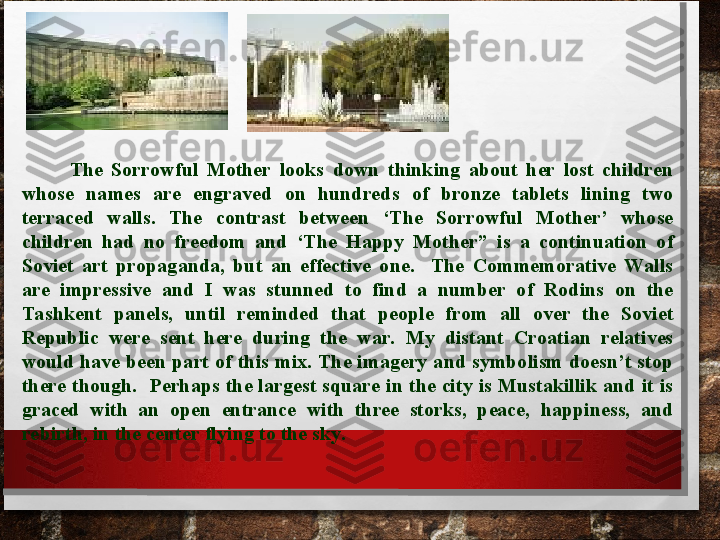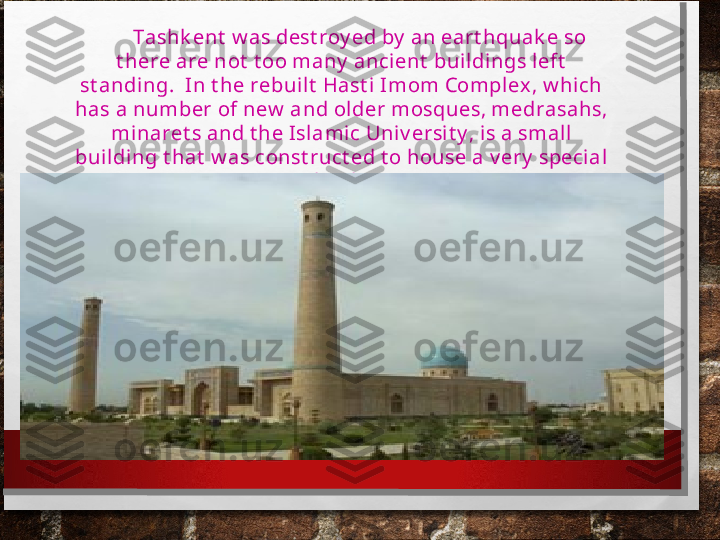Нistory of Tashkent
















Н istory of Tashkent
Н istory of Tashkent Tashkent’s history can be observed from late III century B.C. – time from which the written sources and ancient city inside the contemporary city were preserved. This is the ancient city of Ming Urik situated on the Salar canal. Based on their excavations, the archeologists concluded that the first fortifications of the city were built at the end of I century B.C. - early I century A.D., i.e. the city is already 20 centuries old. Chinese chronicles that were based on the memoirs of the Chinese Ambassador Chjan Tsan with whom the concept of the first caravan route along the Great Silk Road is related can be named among the first written sources.
Starting from IV century A.D. Chach was in the center of many confrontations. In 550 the Turkic Kaganate was established and it included also the conquered Chach. Large groups of nomadic Turkic population intruded it. After fall of the Turkic Kaganate, Chach was governed by local rulers. In VII-VIII В centuries the population was mixed. Ruling elite consisted of Sogdian aristocracy mixed with Turkic one. In 713 Kuteiba’s troops made a destructive campaign to Chach where later the Caliph’s rule was established. At the same time the network of 4 cities and 20 castles with Madinat-ash-Shash holding tthe central role among them had been formed during the early medieval era. Thus called the Arab sources the city, the ruin of which were studied in the ancient city of Ming Urik.
One more name is mentioned in the written sources of IX-X centuries - Binket. It was divided to citadel (arch), internal city (shahristan or madina) and two suburbs - internal (rabad-dekhil) and external (rabad- kharidj). Citadel was surrounded by two gates and contained the ruler’s place, treasury and prison. IX-XII centuries are the era of prospering industry, trade and culture. This period is called the «golden age», «Muslim Renaissance» in the history of economic and cultural development of Movaro-un-Nahr, where Tashkent played one of the key roles.
In 1503 Tashkent was conquered by Sheibani-Khan. Tashkent’s role as economic and cultural center had grown significantly under the rule of Suyunij-Khodja-Sultan, one of the most powerful khans. Struggle between the Sheibanids and Kazakh sultans for owning the capital continued for many decades. In XVI century the grand campaign of civil construction was started in Tashkent. Part of buildings were preserved to our days. In 1554 Nauruz Akhmed became the supreme ruler of the Sheibanids’ state, and cities of Fergana were subjected to him. However, siege of Bukhara was failure г and in Samarkand khan was killed in his own camp. In XVI century Bukhara’s ruler made marches on Tashkent. In 1582 Abdulla-khan finally subjected Tashkent to his rule. During the rule of the first Ashtarkhanids (early XVII century) Kazakh sultans consolidated their position in Tashkent. By that time Tashkent finally acquired its contemporary name.
